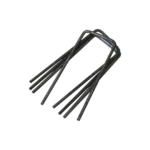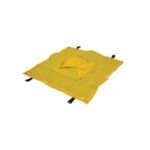A Detailed Guide On Erosion Management Principles

This article is a detailed guide on implementing the best erosion management practices on your construction site.
When it comes to tackling erosion, think of it as a strategic game plan for your construction site. We’ve got some smart principles to share that not only keep the environment safe but also make your project standout.
Minimising the Extent of Disturbance
Staging Works

This is done in order to minimise the amount of earth destabilised simultaneously. This can be undertaken by:
- Only clearing areas when absolutely necessary and progressively rehabilitating them
- Reducing the size of areas where soil stability is disrupted
- Scheduling high-risk activities during drier periods in the year or construction phase
Preserving Existing Vegetation

Vegetation stands as the primary shield against erosion (both by wind and water) on your site and should be conserved in all non-work areas.
The expenses linked with carefully clearing vegetation might outweigh the potential costs incurred by exposing your organization and individuals to ecological harm and legal obligations.
Vegetation prevents soil erosion through the following methods:
- Roots bind soil particles into cohesive structures
- It forms a protective layer over soil, decreasing the impact of raindrops
- Encourages water retention on the surface
- Diminishes surface wind velocity
Vegetation planted on-site requires a certain period to establish itself before it can offer sufficient erosion protection. Maintaining vegetation is advantageous for all soil types.
To safeguard vegetation, a barrier can be installed between the vegetation and the work area. These barriers could encompass temporary plastic or mesh fencing. Barriers should be set up around the outer edge of trees’ canopy dripline, as damage to trees may occur if their root zones are disturbed (generally equivalent to the canopy’s area).
No vehicle, machinery, or material storage activities should take place within the dripline.
In spite of efforts to protect vegetation, it might sustain damage during work. If branches are harmed, they should be cleanly trimmed. Areas of vegetation that are completely destroyed must be replanted.
Drain Management Techniques
Catch Drains

Run-off channels are dug drainage routes utilized to direct water flow to a specific destination. They are suitable in cases where water drainage must be managed for more than 5 days.
It is essential that these run-off channels are dimensioned appropriately to guarantee their capability to accommodate the flow on the premises.
They need to be reinforced within a fortnight of their establishment and subject to frequent evaluations to ensure that:
- Their dimensions are sufficient for the volume of water runoff
- The channel’s surface is not eroding
- The banks have not been compromised by the runoff

Earth Banks
An earth bank is an embankment consisting of densely packed soil. This approach is suitable for cases where water drainage needs management for a duration exceeding 5 days.
Embankments are capable of accommodating lower water volumes compared to drainage trenches. It’s necessary they are sized to ensure they have capacity to convey flows on the site.
Within two weeks of their construction, these embankments should be stabilised and subjected to regular assessments in order to ensure that:
- The size is adequate for the flow
- Erosion is not taking place on the upward slope of the embankment
- The embankment has not suffered damage from the runoff
Energy Dissipaters

Used at the outlet of a down drain or lined channel, an energy dissipater will reduce the velocity and associated erosion from the excess flow.
Energy dissipaters should be regularly inspected to ensure:
- Rocks are not being displaced by the flow
- Sediment hasn’t built up in the rock to a point where it’ll be resuspended during the next storm event (at this point it’ll require rock replenishment or replacement)
Stabilisation Measures
Stabilisation Matting

Stabilization mats serve to shield exposed soils from rain, runoff, and wind. These mats come in various types, including biodegradable, synthetic, and hybrid compositions.
The choice of material should consider:
- Duration of required effectiveness – synthetic options often offer longer-lasting results
- Weed suppression necessity – thicker mats effectively suppress weeds (though they may not be suitable if fostering grass growth through the mat is desired)
- Expected water flow patterns – synthetic mats are often more suitable for concentrated flows
- Biodegradability requirement – if degradation as plants establish is desired, opt for biodegradable mats
Be aware some products can impede water infiltration into the underlying soil. There’s also products which lack the density required to suitably provide zero light transmission to the substrate, and therefore adequate weed suppression.
Stabilisation matting should be regularly inspected to ensure:
- The erosion control mat isn’t being compromised by water runoff
- The mat remains securely in place and unaffected by wind or runoff forces, assuming correct installation
- In cases where biodegradable materials are used, they haven’t degraded excessively soon. If there’s plastic netting reinforcement (not advisable), it’s important to ensure the netting hasn’t become detached, as this could harm birds, small reptiles, and mammals
- The matting isn’t getting buried under sediment. If this happens, it’s necessary to address and manage the root cause of the erosion
Revegetation

Un-stabilised areas should be progressively replanted with vegetation. Where possible planted vegetation should be part of the final landscape design.
Replanting serves to prevent erosion by:
- Enabling roots to bind soil particles together into clusters
- Offering a protective layer to the soil, thereby lessening the impact of rain fall
- Promoting the retention of surface water
- Diminishing the speed of wind at ground level
It takes time for the revegetation process to establish itself before it can effectively counter erosion. To aid the establishment of reforestation and to prevent damage during ongoing work, the following measures should be taken into account when replanting:
- Installing stakes
- Employing tree guards
- Using stabilisation matting at the base
- Establishing ‘no-go zones’
Revegetation with minor damage can involve the removal of impaired branches. In cases of substantial damage to reforested areas, replacement is recommended.
While choosing plant species for reforestation, ensure their suitability for the specific area, taking into consideration factors like soil composition and climatic conditions. For visually prominent areas such as highways, uniformity in planting creates an attractive landscape. Some species might necessitate the application of water and/or fertilizers during their initial growth phase.
Grass Establishment

Areas that have been disrupted due to construction activities can be made more stable by introducing grass. However, grass is not as efficient as preserving existing vegetation, as it requires a period of time to take root and thrive.
Grass can serve both as a long-term stabilization method as part of the site’s reforestation process or as a protective measure during construction activities.
The establishment of grass can be achieved through various methods, including:
- Manual scattering of seeds
- Hydro-seeding
- Application of a mixture of seed and mulch through hydro-mulching
- Laying down rolls of turf
In cases where grass is only being used temporarily for construction protection purposes (e.g., covering stockpiles with grass), it’s advisable to use sterile seeds. This approach is cost-effective and serves both as a stabilization method and offers time for strategically planted native vegetation to take root and grow.
During the process of establishing grass, it might be necessary to reapply seeds in patches where the initial seeding wasn’t successful or where spots were missed.
When using turf, careful monitoring is required to ensure that water runoff flows onto the grass rather than along the edges of the turf strip. If the flow concentrates along the turf edges, it can worsen erosion.
Rock Armouring

A layer of stones can act as a shield, intercepting rain, runoff, and wind to avert erosion of the soil. It can additionally diminish the swiftness of flow and the erosive tendencies linked with it. Sometimes, the flow’s pace can be reduced enough to facilitate the settling of suspended sediment from runoff.
Rock armoring is typically employed in zones with concentrated flow. Its applications encompass:
- Water drainage channels
- Collection drains
- Outfall drains
- Entry/exit points for sediment basins
For temporary applications, rocks may be placed with or without a geotextile liner. In cases where geotextile isn’t utilized, a thicker layer of rocks is necessary.
The selection of rocks should encompass a range of sizes whenever feasible. The smallest rocks must possess the capability to withstand detachment during peak flows.
Regular inspection of rock armor is essential to confirm that:
- Rocks remain undisturbed by the current
- Sediment hasn’t accumulated to a level within the rock layer that would lead to its suspension during the next storm event (in such cases, replenishment or replacement of rocks will be required).
Stockpile Management
Ensure stockpiles aren’t located next to cross drainage regimes or creeks. It’s also advisable not to locate your stock pile beneath the drip line of vegetation as it could cause harm to what you are trying to protect.
Dust Prevention

Spraying Water
Water improves soil cohesion, causing particles to stick together and reducing the likelihood of dust generation. Water may be sprayed via:
- Water carts
- Sprinklers
- Hand-held hoses
Areas to be targeted should include:
- Haul roads or other trafficked areas (not at the access point)
- Areas of earthworks
- Stockpiles
Dust Control Agents
Dust control agents refer to chemical additives that enhance the cohesion among soil particles by strengthening their bonds. Dust control agents that employ water as a carrier substance are typically the most feasible choice for on-site application, as they can be mixed with water sprayed by a water truck to mitigate dust.
Utilizing dust control agents reduces the need for frequent spraying in specific areas, resulting in cost savings related to:
- On-site water consumption
- Water truck utilization
This, in turn, permits the coverage of larger areas for dust control purposes.
When choosing a product for implementation, ensure that its usage won’t generate adverse environmental effects. Request a Material Safety Data Sheet (MSDS) to assess any potential environmental impacts of the dust suppressant and identify necessary measures to mitigate these impacts.
Halt Activities

During severe weather conditions characterized by high temperatures, aridity, and strong winds, it might be necessary to suspend dust-producing activities. Alternatively, all on-site operations could be paused due to concerns related to Occupational Health and Safety (OH&S).
A well-implemented erosion management plan contributes to the long-term sustainability of the project and the surrounding environment. By preventing erosion and sediment runoff, the plan supports the health of local water bodies, preserves natural habitats, and leaves a positive legacy for future generations.
For further information please click here.

 Coir Logs
Coir Logs Coir Blankets
Coir Blankets Coir Mesh
Coir Mesh Jute Matting
Jute Matting Jute Mesh
Jute Mesh Silt Fence
Silt Fence Wooden Stakes / Pegs
Wooden Stakes / Pegs Retaining Pins
Retaining Pins Weed Mat
Weed Mat Weed Mat Pins
Weed Mat Pins Timber Stakes
Timber Stakes Raised Garden Beds
Raised Garden Beds Biaxial Geogrid
Biaxial Geogrid Uniaxial Geogrid
Uniaxial Geogrid Non Woven Geotextiles
Non Woven Geotextiles Sand Containers
Sand Containers Silt Socks
Silt Socks Dewatering
Dewatering Drain Filters
Drain Filters Water Filled Barriers
Water Filled Barriers Edge Protection Barrier
Edge Protection Barrier Hoarding Panels
Hoarding Panels Barrier Mesh & Bunting
Barrier Mesh & Bunting Star Picket Posts & Accessories
Star Picket Posts & Accessories Flood Tubes & Stabilizers
Flood Tubes & Stabilizers Sandbags
Sandbags